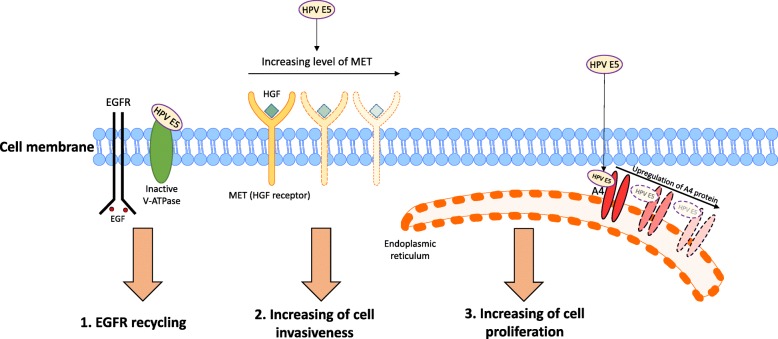Abstract
Human papillomavirus (HPV) is the most common viral infection of the reproductive tract worldwide. It has been well documented that the HPV oncoproteins E6 and E7 play important roles in cancer progression and maintenance. However, the high risk HPV E5 protein is also demonstrated to affect some cellular pathway and signaling in human cell lines. In this letter we argue for the need of further investigation and suggest that the HPV E5 protein should be acknowledged as an oncoprotein of HPV.
Keywords: HPV, Cervical cancer, HPV E5 protein, Tumorigenesis
Letter to the editor
Dear Editor,
Human papillomavirus (HPV) has been proven to be the main cause of cervical cancer worldwide [1]. Most studies, about HPV tumorgenesis, focus on the role that high risk HPV E6, and E7 proteins play [2]. However high risk HPV E5 protein, one of the virus early phase proteins, is demonstrated to have an important effect on cellular and signaling pathways in human cell lines [3]. Many functions have been described for this viral protein, including, cell transforming activity (Fig. 1), influencing cell cycle and growth factors, induction of apoptosis and endoplasmic reticulum (ER) stress, and immune evasion [3]. HPV E5, as a cell transformer, can interact with the 16 KDal subunit of vacuolar-ATPase (V-ATPase) and disrupt acidification of endosomes [4]. This phenomenon enhances epidermal growth factor (EGF) receptor recycling [4]. Additionally, it has been indicated that the E5 protein increases the expression level of Met, a hepatocyte growth factor (HGF) receptor, promoting transformed cell invasiveness [5]. E5 is also shown to be bonded with an A4 protein, a transmembrane lipoprotein of the endoplasmic reticulum, thus regulating proliferation of infected cells [6]. With all of this considered, it is highly suggested that the HPV E5 protein should be acknowledged as an oncoprotein of HPV. Especially, for the production of DNA-based vaccines this can be of utmost importance. As HPV infections are spread more widely around the world [7], also affecting areas that were thought to be protected by it due to more conservative sexual conduct [8], DNA-based vaccines against HPV should contain not only HPV E6 and E7 coding genes [9], but also E5. Novel vaccines could be used therapeutically as well as in a preventive way. Currently, dispensed vaccines are based on the HPV L1 capsid protein and are able to induce protective immunity (by production of memory cells against L1).
Fig. 1.
Effect of HPV E5 protein on cellular pathways
Acknowledgements
Not applicable.
Funding
Not applicable.
Availability of data and materials
Not applicable.
Abbreviations
- EGF
Epidermal growth factor
- ER
Endoplasmic reticulum
- HGF
Hepatocyte growth factor
- HPV
Human papillomavirus
- V-ATPase
Vacuolar-ATPase
Authors’ contributions
Both authors contributed towards the design and writing of the article. Both authors have read and approved the final version.
Ethics approval and consent to participate
Not applicable.
Consent for publication
Not applicable.
Competing interests
The authors declare that they have no competing interests.
Publisher’s Note
Springer Nature remains neutral with regard to jurisdictional claims in published maps and institutional affiliations.
References
- 1.Wakeham K, Kavanagh K. The burden of HPV-associated anogenital cancers. Curr Oncol Rep. 2014;16(9):402. doi: 10.1007/s11912-014-0402-4. [DOI] [PubMed] [Google Scholar]
- 2.Ganguly N, Parihar SP. Human papillomavirus E6 and E7 oncoproteins as risk factors for tumorigenesis. J Biosci. 2009;34(1):113–123. doi: 10.1007/s12038-009-0013-7. [DOI] [PubMed] [Google Scholar]
- 3.Venuti A, Paolini F, Nasir L, Corteggio A, Roperto S, Campo MS, et al. Papillomavirus E5: the smallest oncoprotein with many functions. Mol Cancer. 2011;10(1):140. doi: 10.1186/1476-4598-10-140. [DOI] [PMC free article] [PubMed] [Google Scholar]
- 4.Kim M-K, Kim HS, Kim S-H, Oh J-M, Han JY, Lim JM, et al. Human papillomavirus type 16 E5 oncoprotein as a new target for cervical cancer treatment. Biochem Pharmacol. 2010;80(12):1930–1935. doi: 10.1016/j.bcp.2010.07.013. [DOI] [PubMed] [Google Scholar]
- 5.Scott ML, Coleman DT, Kelly KC, Carroll JL, Woodby B, Songock WK, et al. Human papillomavirus type 16 E5-mediated upregulation of met in human keratinocytes. Virology. 2018;519:1–11. doi: 10.1016/j.virol.2018.03.021. [DOI] [PMC free article] [PubMed] [Google Scholar]
- 6.Halavaty KK, Regan J, Mehta K, Laimins L. Human papillomavirus E5 oncoproteins bind the A4 endoplasmic reticulum protein to regulate proliferative ability upon differentiation. Virology. 2014;452:223–230. doi: 10.1016/j.virol.2014.01.013. [DOI] [PMC free article] [PubMed] [Google Scholar]
- 7.Baseman JG, Koutsky LA. The epidemiology of human papillomavirus infections. J Clin Virol. 2005;32:16–24. doi: 10.1016/j.jcv.2004.12.008. [DOI] [PubMed] [Google Scholar]
- 8.Baghi HB, Yousefi B, Oskouee MA, Aghazadeh M. HPV vaccinations: a middle eastern and north African dilemma. Lancet Infect Dis. 2017;17:18–19. doi: 10.1016/S1473-3099(16)30553-9. [DOI] [PubMed] [Google Scholar]
- 9.Ahn J, Peng S, Hung CF, Roden R, Wu TC, Best SR. Immunologic responses to a novel DNA vaccine targeting human papillomavirus-11 E6E7. Laryngoscope. 2017;127(12):2713–2720. doi: 10.1002/lary.26737. [DOI] [PMC free article] [PubMed] [Google Scholar]
Associated Data
This section collects any data citations, data availability statements, or supplementary materials included in this article.
Data Availability Statement
Not applicable.



